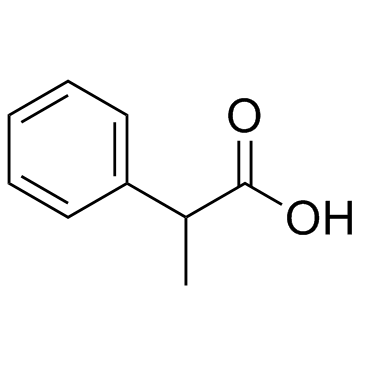DL-2-Phenylpropionic acid

DL-2-Phenylpropionic acid structure
|
Common Name | DL-2-Phenylpropionic acid | ||
|---|---|---|---|---|
| CAS Number | 492-37-5 | Molecular Weight | 150.174 | |
| Density | 1.1±0.1 g/cm3 | Boiling Point | 260-262 ºC | |
| Molecular Formula | C9H10O2 | Melting Point | 5 ºC | |
| MSDS | Chinese USA | Flash Point | 148 ºC | |
| Symbol |

GHS07 |
Signal Word | Warning | |
|
A chiral separation strategy for acidic drugs in capillary electrochromatography using both chlorinated and nonchlorinated polysaccharide-based selectors.
Electrophoresis 35(19) , 2807-18, (2014) A generic chiral separation strategy for the analysis of acidic compounds in CEC is proposed in completion of an earlier defined strategy for nonacidic compounds. The screening step of this strategy uses a 45 mM ammonium formate (pH 2.9)/ACN (35/65, v/v) mobi... |
|
|
Activation of TLR3 promotes the degeneration of retinal ganglion cells by upregulating the protein levels of JNK3.
Invest. Ophthalmol. Vis. Sci. 56(1) , 505-14, (2015) To investigate whether activation of Toll-like receptor 3 (TLR3) promotes the degeneration of retinal ganglion cells (RGCs) by upregulating the protein levels of c-jun N-terminal kinase 3 (JNK3).Toll-like receptor 3-specific activator, Poly(I:C) (polyinosinic... |
|
|
Antioxidant and Antiinflammatory Compounds in Nutmeg (Myristicafragrans) Pericarp as Determined by in vitro Assays.
Nat. Prod. Commun. 10 , 1399-402, (2015) Nutmeg, Myristicafragrans, is known for its culinary and medicinal values. The nutmeg pericarp, abundant during the production of the seed, is also used in food and beverage preparations. In this study, the pericarp of M. fragrans was evaluated for its bioact... |
|
|
2-Arylpropionic CXC chemokine receptor 1 (CXCR1) ligands as novel noncompetitive CXCL8 inhibitors.
J. Med. Chem. 48 , 4312-31, (2005) The CXC chemokine CXCL8/IL-8 plays a major role in the activation and recruitment of polymorphonuclear (PMN) cells at inflammatory sites. CXCL8 activates PMNs by binding the seven-transmembrane (7-TM) G-protein-coupled receptors CXC chemokine receptor 1 (CXCR... |
|
|
Cytotoxicity of the mycotoxins deoxynivalenol and ochratoxin A on Caco-2 cell line in presence of resveratrol.
Toxicol. In Vitro 29 , 1639-46, (2015) Exposure to mycotoxins through dietary food intake involves a highly complex scenario where co-contamination of different mycotoxins has been frequently demonstrated. On the other hand, the effect of the interaction of mycotoxins with other generally consider... |
|
|
Production of S-(+)-2-phenylpropionic acid from (R,S)-2-phenylpropionitrile by the combination of nitrile hydratase and stereoselective amidase in Rhodococcus equi TG328.
Appl. Microbiol. Biotechnol. 39(6) , 720-5, (1993) A new soil isolate, tentatively identified as Rhodococcus equi TG328, was found to be effective in the production of S-(+)-2-phenylpropionic acid from (R,S)-2-phenylpropionitrile. The conversion is catalysed by two enzymes. First, a nitrile hydratase converts... |
|
|
Stereoselective metabolism of 2-phenylpropionic acid in rat. I. In vitro studies on the stereoselective isomerization and glucuronidation of 2-phenylpropionic acid.
Drug Metab. Dispos. 15(4) , 529-34, (1987) Optical isomerization of 2-phenylpropionic acid (hydratropic acid, HTA) was studied in the organs of male rat in vitro. (R)-(-)-HTA was not isomerized by rat liver homogenate even after the addition of CoA, ATP, and Mg2+ to the incubation mixture; however, it... |
|
|
Substrate specificity and enantioselectivity of arylcarboxylic acid glucuronidation.
Drug Metab. Dispos. 16(4) , 627-34, (1988) A general and sensitive HPLC method using a precolumn switching system was developed for the separation and quantification of the individual diastereoisomeric glucuronides of the 2-phenylpropionic acid optical isomers. Kinetic properties of rat liver glucuron... |
|
|
Enantioselective covalent binding of 2-phenylpropionic Acid to protein in vitro in rat hepatocytes.
Chem. Res. Toxicol. 15(11) , 1480-7, (2002) A series of studies was conducted to investigate the potential of (R)- and (S)-2-phenylpropionic acid (2-PPA) to undergo enantioselective covalent binding to protein in freshly isolated rat hepatocytes and to determine whether such covalent binding is depende... |
|
|
Application and comparison of high performance liquid chromatography and high speed counter-current chromatography in enantioseparation of (±)-2-phenylpropionic acid.
J. Chromatogr. A. 1281 , 79-86, (2013) High performance liquid chromatography (HPLC) and high speed counter-current chromatography (HSCCC) were applied and compared in enantioseparation of 2-phenylpropionic acid (2-PPA) when hydroxypropyl-β-cyclodextrin (HP-β-CD) was used as chiral mobile phase ad... |